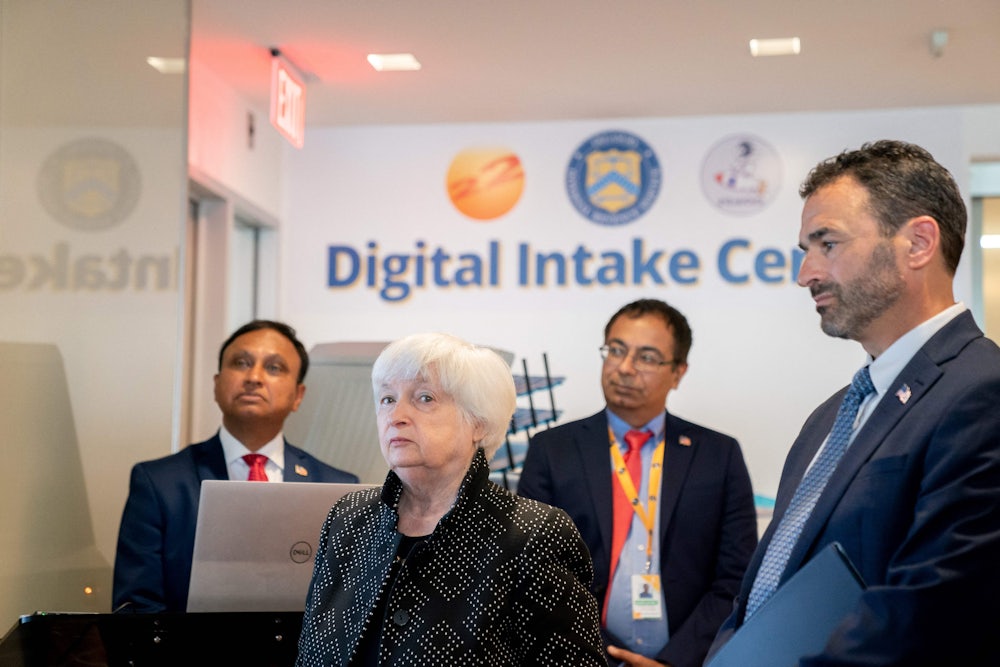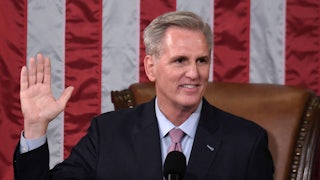“The Era of Big Taxes Is Upon Us” announced a Wall Street Journal headline earlier this week. You could have fooled me. In 1980, according to the nonprofit Tax Policy Center, the average total tax burden in the United States was 22.4 percent of household income. That was President Jimmy Carter’s last year in office. By 1988, President Ronald Reagan’s last year in office, that had fallen to 21.9 percent. By 2019, the last year for which the Tax Policy Center has any data, it was down to 19.4 percent. Federal tax rates haven’t changed significantly since 2019—despite President Joe Biden urging Congress to increase them on corporations and households earning $400,000 or more—so the average tax burden, as a percentage of income, isn’t likely much different today than it was then. So what’s the Journal talking about?
It’s talking about taxes as a percentage of gross domestic product, which are up in the United States but still quite low compared to other countries in the Organization for Economic Cooperation and Development. In theory there’s some point at which taxes become so great a percentage of GDP that economic growth suffers. But in observable fact there’s little evidence of that happening even in France and Germany, where, the Journal’s Tom Fairless reports, taxes are today higher as a percentage of GDP than at any point since 1965. The real challenge, in other OECD nations and in the U.S., will be to address twenty-first-century problems (Fairless mentions global instability, an aging population, and climate change) without becoming insolvent. That will require higher taxes everywhere but especially in the U.S., where increasing taxes is easier from an economic point of view than in higher-tax OECD countries—but much more difficult from a political point of view.
By almost every measure, Americans are undertaxed, and have been for at least four decades. Treasury gets most of its revenue from the income tax. Between 1980 and 2019, the average income tax burden fell from 11.8 percent of income to 9.3 percent. Treasury’s third-largest revenue source is the corporate income tax, which also fell during this period, from 2.8 percent of income to 1.5 percent. The only tax burden that increased between 1980 and 2019 was that of the federal payroll tax, which pays for Social Security and Medicare and is one of the country’s most regressive taxes. The payroll tax is mostly a flat tax of 15.3 percent (half paid by your employer if you’ve got one) that every wage earner is required to pay. That’s one way it’s regressive. The other way is that any income above $160,200 is mostly exempt from the payroll tax. (I say “mostly” because a progressive component—a 0.9 percent tax on incomes above $200,000—was added to the Medicare portion of the payroll tax to pay for the Affordable Care Act.)
But when the Journal said that we’ve entered an era of big taxes, it didn’t mean big payroll taxes. (In the U.S., the payroll tax should be eliminated and replaced with a higher income tax to make federal taxation more progressive overall.) Mostly the Journal meant those other countries where overall tax revenues are rising as a percentage of GDP. In France taxes have risen to 46 percent of GDP, and in Germany to 39 percent.
Where does the U.S. fit in? In 2018 taxes represented 25 percent of GDP (as opposed to income). In 2022 they represented 27.7 percent of GDP. Perhaps the increase reflects rising incomes; median household income rose, after inflation, from $73,030 to $74,580. Meanwhile, the Covid epidemic made GDP growth completely screwy, falling 2.8 percent, after inflation, in 2020, then rising an astounding 5.9 percent in 2021 before settling down to 2.1 percent in 2022. It doesn’t pay to extrapolate too much from economic data surrounding the Covid era, because the pandemic made everything go haywire.
The longer-term trend, OECD data show, is that the tax-to-GDP ratio in the U.S. has remained quite stable over the past 23 years, never falling below 20 percent or rising above 30 percent. The ratio has been less stable over the long term in France and Germany, but what really jumps out is how light the tax burden is in the U.S., still the richest country on earth, compared to its peer nations in the OECD. There’s good news in this, and also bad.
Let’s start with the bad news. What the hell, America? Your GDP, at roughly $27 trillion, is 51 percent larger than China’s. Your per capita GDP is bigger than that of any country in the nominal-GDP top 10, even though your population is significantly larger than the others save China and India. Yet your tax burden as a percentage of GDP ranks a stingy thirty-first out of 38 OECD countries: lower than Poland’s (35.2 percent), lower than Estonia’s (32.8 percent), lower than Latvia’s (30.2 percent). What does your penny-pinching get you? The ninth-highest poverty rate in the OECD and the fourteenth-lowest life expectancy at birth. Even when Donald Trump is not president, you’re a rich country doing its damnedest to impersonate an impoverished backwater.
There’s no sign this will improve anytime soon, and certainly not in the 2024 election year. Biden’s own Democratic Party spurned his efforts to increase the top marginal income tax rate, the corporate rate, and taxation of inheritances. And even these measures were inadequate; his proposed corporate tax increase, for instance, would have raised the current 21 percent to 28 percent, even though as recently as 2017 the top rate was 38.9 percent and the sky didn’t fall. For the foreseeable future the U.S. will cover increases in spending through debt, even though, as Fairless points out, debt is more expensive today than it’s been in a generation, even with Wall Street tycoons no longer shorting Treasuries.
So what’s the good news? Well, Fairless reports that the so-called Washington consensus, “which emphasized a reduction in state support for businesses, the removal of regulations impeding competition and trade liberalization” no longer holds much sway in Europe or Japan. That raises some hope that the Washington consensus will eventually die off in Washington too. Should that happen, “the U.S. has more scope than many countries to raise taxes,” Fairless notes, because taxes start out at a much lower proportion of GDP.
In September, Emily Zhang observed in a blog post for the nonprofit Economic Policy Institute that to stabilize at current levels, the U.S. debt-to-GDP ratio would require either raising taxes or lowering spending by 2.2 percent and that “this is eminently doable through tax increases alone.” Recall that as a proportion of GDP, taxes in the U.S. rose 2.7 percentage points between 2018 and 2022 without anybody much noticing.
Better still, though, would be to raise revenue levels to those of our peer nations. Zhang calculates that would require an increase five times what’s required to stabilize our debt-to-GDP ratio, or $2.61 trillion. So yes, that’s a taller order. But as long as we’re daydreaming, why not think big? Americans have large, unmet needs. We can address those needs, balance the budget, and still enjoy the biggest economy in the world by raising significantly our level of taxation. We don’t need to have a small government to keep debt under control. I look forward to the day when an American politician dares to say that out loud.






